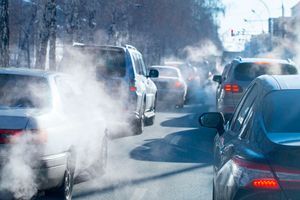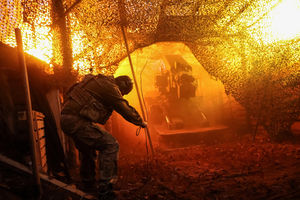Can we climb out of this hole? The climate crisis of our times

Droughts have increased in frequency and magnitude. Farming seasons are no longer predictable. Angry lakes are swelling and the cost of living is rising bizarrely fast.
What you need to know:
- In this series of Healthy Nation special reportage, our journalists delve into the country’s climate crisis, reporting on the link between climate change and human life, hits and misses in climate interventions and expectations at COP27.
What is the extent of the climate crisis in Kenya? In what ways has it altered the course of life in the country?
‘Healthy Nation’ looks at some of consequences of climate change and speaks to ordinary Kenyans about how these destructive events have impacted their lives.
Editor's Note: My first phone at 16 and the collapse of a farming empire
By Jane Njoroge
I bought my first cell phone in 2005. At the time, you would hardly come across a student who owned a phone — but here I was with a brand new gadget, all thanks to my father’s farming business in Laikipia County.
He practised mixed cropping, farming various kinds of fruits, vegetables, maize, beans and sweet potatoes. My siblings and I had been allocated a portion of land where we also grew crops. After every bounty harvest, we would sell the produce and make money. And that’s how I got to own a phone aged only 16.
Of course owning a phone at such an age was a big deal those days.
I remember that it didn’t work very well due to poor network, but it didn’t matter. This was my first phone that let me make calls and send messages.
But fast forward to 2022, my village is dry and semi-arid.
A constant heat wave has dried out all crops. Even my neighbour who used to keep dairy cattle now buys milk from the local shops.
In recent years, smallholder farmers in this region have been hit hard by droughts and resulting food insecurity. They have helplessly watched their crops wither while livestock become emaciated to bones and drop dead amid droughts.
Recent erratic changes in rainfall patterns have lead to low agriculture production, thus creating food insecurity for an ever-increasing population. Floods and famine are the consequences of these changing patterns. This is even as the world continues to get warmer at an alarming rate. The weather has become so unpredictable that many farmers who relied on rain-fed agriculture have had to find other sources of livelihoods. And as the world converges in Egypt this week for the 2022 United Nations Climate Change Conference (COP27), it is a moment to rethink our adaptation approach in tackling the effects of climate change.
In this series of Healthy Nation special reportage, our journalists delve into the country’s climate crisis, reporting on the link between climate change and human life, hits and misses in climate interventions and expectations at COP27.
Why this year's COP stands out
By Amina Wako
What is ‘COP’?
The word ‘COP’ is an acronym for ‘Conference of the Parties’.
In regards to Climate Change, COP is the highest decision making body of the United Nations Framework Convention on Climate Change (UNFCCC).
There are about 198 countries that are part of the UNFCCC and are called ‘Parties’ hence, Conference of Parties.
At a UN Earth Summit that happened in Brazil 30 years ago, countries came up with three conventions on Biodiversity, Climate Change and Desertification. These are called the Rio Conventions. Each of these three categories have their own COPs.
The COP has met annually since 1995 to discuss and agree how to jointly address climate change and its impacts.
The first COP, which was named COP1, took place in 1995 in Berlin, Germany. This year, we will have the 27th COP since then, hence –COP27. It will be held in Sharm-El Sheikh, Egypt. Countries have been meeting for COPs every year. It is only in 2020 that the COP was pushed to the following year because of the Covid pandemic.
This is the fifth time Africa is hosting COP. ( Morocco twice, Kenya and South Africa).

Former Environment and Forestry CS Keriako Tobiko at the COP26 Plenary Session in Glascow, Scotland on October 30, 2022. This year's COP is being held in Africa.
Kenya, in 2006, hosted the first East African COP in Nairobi. The first-ever African COP was held in Marrakech, Morocco. in 2016
While we have had a number of COPs, there are those that stand out. For instance, the 21st Session of the COP (COP21), which was held in Paris, France, in December 2015, was historic because parties had the first international climate agreement. This was named the Paris Agreement.
After 20 years of negotiations, they agreed to work together to limit global warming to below 2 degrees and aim for 1.5 degrees Celsius. They also vowed to adapt to the impacts of a changing climate and to make money available to deliver on these aims. It is at this COP that parties agreed to come up with Nationally Determined Contributions which keep countries in check and ensure they reduce greenhouse gas emissions as well as adapting to climate change. These are submitted after every five years to the UNFCCC.
Some people have labelled this year’s COP, the African COP, because it is being held on African soil. Every country will be pushing their own agenda through their Party Groupings.
These parties are grouped in different regions. Kenya for instance, is part of the Africa Group of Negotiators and they have been meeting their member countries before the COP to discuss their position on issues. The country is already bearing the brunt of the climate crisis. We have had severe spells of drought for about three years now and people, as well as animals have lost their lives.
Like most African countries, we are hit hardest by the crisis despite being the least contributors to climate change. Such issues are usually at the core of COP discussions and African countries will push for, among other things, climate finance that will cater for adaptation and mitigation measures as well as Loss and Damage.
This year’s COP begins on November 4 and ends on 18th of the same month.
What Kenya should push for at climate conference in Egypt
By Pauline Ongaji
The world will be converging for the 2022 United Nations Climate Change conference 2022, more commonly referred to as COP27, which will be held in Sharm El Sheikh, Egypt, between November 6 and 18.
This being the 27th conference, many will argue that they now have a much clearer understanding of the extent of the potential climate crisis and what needs to be done to address it effectively.
But in developing countries like Kenya, that is not the case. There are many who see this just like another global conference for the elite.
Healthy Nation spoke to Dr Paul Matiku, an ecologist and conservation and development expert, on the importance of the conference and what is at stake for the common citizen.
This is an excerpt of the conversation with Dr Matiku, who is also the executive director for Nature Kenya.
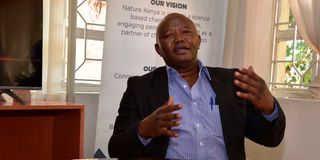
Dr Paul Matiku, the executive-director of Nature Kenya.
First of all, what climate crises are being faced by Kenya?
In the developing world across the world, people heavily depend on the natural environment for their health and livelihoods. A healthy environment means we can access supplies of the necessities of life such as water, food and air.
As a developing country, Kenya is facing the crises of hunger, shortage of rainfall and water, as well as loss of livestock among other disasters, resulting from climate variability.
Our economy is heavily agriculture-based. As such, inadequate rainfall has affected us badly. Prolonged droughts devastate food supplies and dry up water sources. Withered crops and starving animals destroy families’ livelihoods. Insufficient rain lowers our hydropower capabilities. As a result, our manufacturing capacity is affected. This leads to loss of jobs. The economy is impacted negatively.
Based on these challenges, what should Kenya’s priorities at the COP27 be?
To push for a reduction of emissions from all parties, since we are the ones bearing the biggest brunt as far as climate change is concerned. Additionally, the issue of financing is a top priority. Pledges that have been made by the developing world to support poor nations to mitigate climate change have to be released. The conditions the money comes with must be lessened.
In the past, these conditions have made access to the money difficult. The bureaucracy also limits how much money gets to the intended purposes.
What is the responsibility of the developed world to this crisis?
We understand that all governments are responsible for reducing their environmental footprints. This is where the issue of equity comes in. Big economies are responsible for releasing a lot of carbon dioxide as compared to the developing world. Even per capita, an average citizen in the developed world emits a significant amount of carbon dioxide as compared to the average citizen in a developing country like Kenya. This is mainly through their lifestyle. Ironically, though, we share the atmosphere and end up paying the biggest price.
For them, it will be to get a little colder or hotter than usual. For us here in the developing world, it means drought, poverty and hunger. This is because our ability to cope is limited. We need money to finance climate change adaptation mechanisms.
It is the fifth time the conference is being held in Africa. People are excited. How important is it that the event is being held on the continent?
It makes it easier for better preparations on the part of African countries. In terms of participation more African leaders and heads of government are likely to attend. This will awaken more people to the issue of climate change. Besides government representatives, the civil society and other stakeholders will participate.
That said, hosting the conference does not give Africa an upper hand or any advantage in the negotiations.
African countries have been reduced to spectators or lobbyists in such conferences. Why is that?
The biggest problem has been lack of knowledge. When it comes to participating in such important conferences, most Africans countries always see this as an opportunity to make money through per diems.
We tend to send technocrats and people who understand what climate change as opposed to those who would make a stronger case. This limits our negotiating power.
Others see this as an opportunity to travel while others come with the mentality of not working past 5pm. So while they are partying at night, negotiations are ongoing. Our people wake up to ready agreements they must commit to.
There is also the issue of African delegates staying in remote areas. This is perhaps due to the cost. When you travel for long distances to participate, this limits your negotiation capabilities.
Most sadly, though, we still subscribe to the idea of endorsing what others say instead of standing our ground and defending our rights. Notably, developed countries do not compromise their stand.
Can we climb out of this hole? The climate crisis of our times
By James Kahongeh
If the world is on the brink of a climate catastrophe, Kenya is living its horrendous consequences every day.
Droughts have increased in frequency and magnitude. Farming seasons are no longer predictable. Angry lakes are swelling and the cost of living is rising bizarrely fast. Kenyans are now experiencing first-hand the soreness of a changing climate in ways they have not done before.
For the first time in decades, drought has killed more elephants in Kenyan parks than poaching, with hundreds of wildebeests, zebras, gazelles and other grazers starving to death owing to scarcity and even absence of foliage.
As the climate calamity escalates and critical resources dangerously thin out, climate conflict is now threatening to drive the last nail into the coffin of an already hopeless situation.
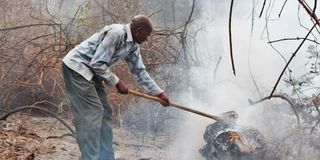
Mzee Mutua Mangeli, a volunteer fire-fighter, combs a charred section of Kitondo Forest in Makueni County on October 26, 2022. A wave of wildfires has destroyed 1,200 acres of forest land in the county in the last three weeks.
These past two weeks, two villagers have been killed in Kitui County by camel herders from the neighbouring Tana River County as drought forces the pastoralists to move farther from their traditional grazing fields in search of pasture.
Meanwhile, there are now frequent fires in Mount Kenya and the Aberdare, the country’s two largest forest ecosystems, underscoring a relentless threat that is upending everything in its path.
As the word descends on Sharm-el-Sheikh in Egypt this week to explore hits and misses of climate interventions, Kenya will be keen to see how some of its pain points are addressed.
But what is the extent of the climate crisis in Kenya? In what ways has it altered the course of life in the country? Healthy Nation looks at some of consequences of climate change and speaks to ordinary Kenyans about how these destructive events have impacted their lives.
Fruitless fields
John Njuguna, Nyandarua farmer
It is difficult to recognise the Nyandarua I have known all my life. Times have changed terribly. Agriculture in Ndaragwa Sub-county was never a trial and error affair. You were certain to get good produce from your farm.
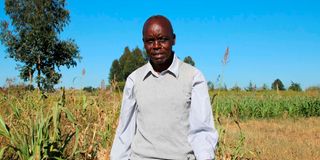
John Njuguna, a farmer in Ndaragwa, Nyandarua County.
We used to harvest between 18 and 25 bags of maize from an acre piece of land. The same piece would yield between 18 and 20 bags of wheat. These days you cannot get two bags of maize because there is no enough rain. The maize stocks cannot even be used to make silage. It is a waste to plant wheat.
Now we cannot grow enough food to feed our families because the rains have disappeared. When they come, they are short and insufficient.
I have never seen families in Ndaragwa go hungry as they are now. We used to grow our own food. We are now buying food. It is incomprehensible that we have been forced to take up kitchen gardening to feed our families. We grow vegetables for own consumption using wastewater from their kitchens. It is the only way to survive.
Casual labourers are suffering the most because some cannot afford to buy maize flour. I have seen my neighbours eat ugali with black tea.
We have now resorted to beekeeping to survive. Keeping bees is safer to practice because they require only a little rain. When it rains, they can survive on the resulting vegetation for several weeks. Nyandarua County government trained us on beekeeping when it became unsustainable to farm food crops.
I have invested in five hives on my land. By selling a kilo of honey at Sh500, I am able to fend for my family. But still, this venture cannot get close to the fortune we had when we were farming maize and other food crops.
Little farming happens anymore in Central Ward, Kiriita and Leshau Pondo areas. Those close to Pathi and Wiyumiririe rivers are able to practise irrigation and grow food for their families. Those living far from rivers cannot grow anything anymore.
In this area, we do not have water pans that can support agriculture. The ones available are too small and are only used to water animals. Many of these are drying up.
In the next few years, it will be difficult to farm in Ndaragwa. Unless we get support to drill boreholes to water our farms.
Flash floods
Esher Wanja, resident - Kibera
I have lived in Kibera for many years, and every rainy season is a dreadful time for us. We experience flash floods and destruction with every little rain in Nairobi or in the upper part of Ngong River.

Families rendered homeless by floods in Kibera, Nairobi on May 14, 2021.
I have lost household belongings, including beddings and furniture, to flash floods. Before, we could tell when it was going to rain and move away to safer higher ground. These days, it rains without warning. I am ever anxious of when floods will find me with my four children.
Over the years, the rains have become more irregular. When it rains, it does so in torrents, causing a lot of damage and even death. Our community-based organisation (CBO) Weather Mtaani tells us that this happens because of climate change. We were expecting rainfall in October, for instance. But it did not rain.
Most of the families that suffer loss are those who live in structures very close to the riverbed in Lindi and Andolo. Houses farther from the river are usually more expensive. I am a casual labourer with no regular source of income. I am only able to rent for a house away from the riverbed for a few months before going back close to the river.
Whenever the river floods, we are sure to discover human bodies that have been washed from upstream, and others of people who have drowned.
Besides the floods, families here suffer during occasional periods of extreme heat. It has become hotter in Nairobi in recent years. Most of us live in tin houses and the heat is too much to bear during daytime. It is even more difficult for families with babies and small children.
Some scientists who have been visiting the neighbourhood have warned that the next heatwave will more devastating than the last one in 2019.
We live in constant fear of what danger will invade first. Is it a heatwave or floods? Everyone here dreads that day. But we have nowhere else to go. This is the only home we know.
Hawa Muhmed, pastoralist
Every morning when I wake up, I head out to the compound to collect carcasses of my goats and sheep that have died during the night. When a goat or sheep is too weak, you carry it home from the field. But you carry it home knowing it will eventually die. You just try to prolong its life by days. When camels, donkeys and cattle are weak, you leave them to die in the wild. It is no use carrying them home.
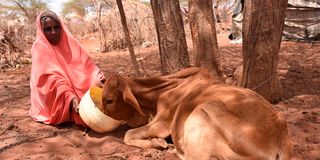
Hawa Muhmed feeding her sick cow at Saka,Mbalambala sub-county in Garissa County on November 4,2021.
This is the worst drought I have witnessed in the last 20 years. There have been dry spells in my life, but few have come close to what we are experiencing now. I have lost more animals in the last two years than I have lost in all past droughts combined. I am now a poor widow.
We do not have any other means of livelihood apart from keeping livestock. This is how I have raised my 11 children. My parents raised my siblings and I by herding. As a young girl in Balambala, I remember my father and uncles owned large herds of cattle, goats, camels, donkeys and sheep. Every villager had a sizeable number of livestock. These days it is difficult to keep such numbers of animals.
The herds in this locale have been reducing drastically over the years. Two years ago, I had 35 goats and sheep. Only five have survived while the rest of the herd perished from the drought. My only heifer died last year after weeks of trying to resuscitate it with supplements. I feed them whatever little my family is eating. I am not sure they will survive if the drought goes on.
For the first time, I am worried about losing my entire stock. Many families here have lost every animal they had. There is nothing for their children to live off or to inherit.
Each animal that dies exposes my young children to starvation. Keeping livestock is the only life we know. It is what generations before us did. What will we do when we can no longer keep animals? How will our families survive? We cannot till this land. But even if we did, would crops survive the drought? There is nothing left for us. Our land has become unliveable. I worry for myself. But I worry more for my children. I see darkness in the days to come.
Expensive fuel
Anthony Ndungu, motorist
I am worried by the high cost of fuel. Two years ago, my friends and I would go for road trips across Kenya. We were never worried about fuel. At the time, I would spend Sh2,000 to fill a 22-litre tank. These days, I spend twice as much to fill the tank.
Owing to the high cost of petrol, I use the car strictly on necessary errands. I cannot afford to drive across the city for routine activities anymore.
I understand how climate change manifests and the contribution of fossil fuels to escalate the phenomenon. While there have been different interventions to reduce carbon emissions, it is difficult to avoid them at all, especially for a developing country like Kenya. There have been suggestions to invest in electric cars, which is a good idea. Would I want one? Of course I would. But I cannot afford one. Millions of Kenyans cannot either. I do not see myself acquiring a new car in the next three years. I will continue to drive the one I have. I would not mind getting a faster Subaru. But that would mean forking out more money to upgrade and to fuel it.
My energy consumption is distributed across solar, oil and hydro. At home, I use solar power to heat water and electricity for other uses such as lighting. The cost of hydropower has shot steeply in the past few years, and buying tokens is a nightmare.
Wildfires
For decades, incidents of wildfires in Aberdare and Mount Kenya national parks have occurred sporadically, and would be put out with ease by government authorities and locals. Now these fires are more frequent and deadlier, often burning for weeks and destroying hundreds of hectares of vegetation and killing thousands of animals.
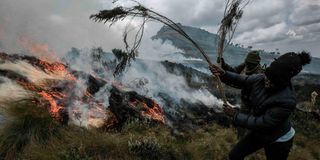
Residents extinguish the edge of a burning area to stop the spread of fire at Aberdare National Park on February 7, 2022.
In the last 10 years, Aberdare National Park alone has experienced at least three major fires, including in 2012, 2018 and in February this year.
By last week, a huge fire had been burning for four weeks in Mbooni Sub County of Makueni County, having started on October 2nd this year in the most horrific case of wildfire in the region. Having started only mildly last month in Kitondo forest, the inferno has now spread to nearby forest blocks such as Katenda and Makuli, with four flashpoints. As of last week, 500 acres had been razed down by the fire, according to county head of Kenya Forest Service (KFS) Evans Maneno.
‘‘The fire is burning fast owing to the ongoing drought in the area as a result of climate change,’’ explains Maneno. KFS warns the fires could pillage vast sections of these forests as putting them out has been complicated by the hilly nature of the area as surging winds complicate the efforts.
But this incident of fire is surprising to Kenya Forest Service personnel. Being a traditionally wet region – the area receives a considerable amount of rainfall, is humid and greener than most parts of the expansive county – as it is, Mbooni is not the place a wildfire would be expected. Much less during the months of October and November when the country experiences short rains.
Says Daniel Mangeli, a local: ‘‘I have lived here for many years without witnessing a fire in this forest. None has burnt for so many days in my lifetime. We are worried wild animals and pests fleeing the fire will come to our homes.’’
Deaths of wildlife
‘‘Elephants converge around dry ponds in parks and starve to death. The situation is unlike anything I have seen before,’’ says Richard Turere, the founder of Lion Lights.
Jumbos at Amboseli and Tsavo national parks are dying in tens for lack of herbage to feed on as the worst drought in decades ravages the facilities.
Turere says he and his friends had organised a one-week tour of Amboseli two weeks ago, only to drive back to the city after just a day.
‘‘There is hardly anything to see in the park. Carcasses lie all over. Entire herds are being wiped, from mature bulls to calves. We risk losing this population,’’ says of the devastation.
He adds: ‘‘For those who have had doubts about climate change, the carcasses of wildlife in our parks is all the evidence you need to believe this is real.’’ Considered the worst in 40 years, the current drought has killed 60 Grevy Zebras, the world’s rarest zebra species, in the past four months. Sixty (or two per cent) may sound negligible, but to put the figure into perspective, there are only about 3000 Grevy Zebras in the world. Kenya is home to 2500 of these.
With little sign that the drought will abate, there is fear the population will further be decimated in coming months. ‘‘It has to rain in the next two weeks. Otherwise the story will change.’’
Abnormally high rainfall
While drought pummels some parts of the country, unusually high rainfall and floods are overrunning others. In 2021, heavy rainfall caused floods in multiple counties in Kenya, with Kisumu, Migori, Tana River, Busia and Homa Bay at the receiving end of destruction.
These counties have perennially experienced flooding owing to their topography. But now there is a new pattern. Every year, the floods are more devastating than the previous ones. In Nyando in Kisumu, for instance, last year’s floods were the worst since 1963, according to area legislator Jared Okello. The floods in the Lake Basin were returning after a similar wave of destruction in 2020. In their wake, crops in more than 4200 of farmlands were destroyed and hundreds of livestock killed, putting food security of the locals in utter jeopardy.
Residents say the rains and floods have bright with them poisonous snakes and waterborne diseases that threaten their lives.
Kenya's climate interventions: The hits and misses
By Leon Lidigu
Former President Uhuru Kenyatta’s government scored well in the local and global climate change agenda but a number of missed opportunities and hurdles stood on his way to making the country climate resilient.
Hits
1.Plastic ban
This year, the country marked five years since the ban on the manufacture, sale and use of single-use plastic carrier bags.
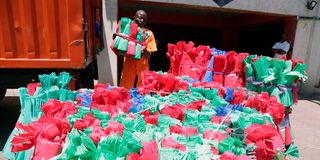
Foam Mattress Ltd worker loads non-woven bags onto a manually operated forklift to transfer to a shopping warehouse at Tuffoam Mall in Kisumu on November 13, 2019. This year, Kenya marked five years since the ban on the manufacture, sale and use of single-use plastic carrier bags.
In an exclusive interview with Healthy Nation earlier this year in Nairobi on the sides of UNEA 5.2 which was the fifth session of the United Nations General Assembly , Monica Medina, US assistant secretary for oceans and international environmental and scientific affairs, disclosed that America respects Kenya’s resolve to ban plastics amid reports that a US industry group representing the world’s largest chemical makers and fossil fuel companies has been lobbying to influence trade negotiations with Kenya with hopes that Nairobi would reverse its strict limits on plastics. But Kenya stands firm on this. However, small business owners still smuggle plastic wrapping papers from across Kenya’s borders.
2. Global climate meeting host
It is under President Kenyatta’s leadership that the country has increasingly emerged as a preferred destination and host if not co-host of very many vital global climate and environment meetings and this has immensely boosted the country’s image overseas.
In 2022 alone, the country has hosted UNEA 5.2, UNEP @50 to commemorate the 50th anniversary of the establishment of the United Nations Environment Programme (UNEP) apart from co-hosting Stockholm +50 with Sweden after which President Kenyatta presided over a High Level Side Event dubbed – ‘On The Road to Lisbon’ on June 3, 2022 before travelling to Portugal.
President William Ruto has assured that the country will prominently feature in what is regarded as the ‘African COP’ as the world converges for the 2022 United Nations Climate Change Conference (COP 27) which will be the 27th UN climate conference and will be held in Sharm el-Sheikh, Egypt.
3.Waste management
In July this year, Kenya’s Sustainable Waste Management Bill 2021 took effect and requires businesses and residents to sort and manage their waste.
In an interview with Healthy Nation, the Principal Secretary at the Ministry of Environment and Forestry explained that waste control is immensely affected by plastics.
“As a country, our focus when it comes to waste control is particularly on plastics because in this part of the world, we were the first country to ban the use of single-use plastics, which we followed with a prohibition of the use of plastic bags or bottles in our protected areas like forests and national parks.”
4.NDCs
In the aftermath of COP21 in 2015, the government advanced a Climate Change Bill to ensure the delivery of the first Nationally Determined Contributions (NDCs) objectives.
NDC is the climate action plan set out by every party to the United Nations Framework Convention on Climate Change (UNFCCC) to cut emissions in a bid to achieve the goal of Paris Agreement and adapt to climate impacts. Parliament went ahead and passed the Climate Change Act, No. 11 of 2016 and was afterwards fully engaged in the preparations of the second NDCs.
The updated NDCs were submitted to UNFCCC in December 2020 as part of the preparation for COP26.
5. Blue Economy
Kenya hosted the inaugural Sustainable Blue Economy Conference on November 26-28, 2018 in Nairobi which was attended by over twenty world leaders and dozens of climate organisations. Kenya has since prioritised the sustainable use of ocean resources for economic growth, livelihoods and jobs, and ocean ecosystem health.
With support from the European Union to a tune of Sh971 million, the Kenyan Ministry of Transport, Infrastructure, Housing, Urban Development & Public Works has from 2017 working to implement a project named ‘Institutional support to the Kenyan Transport Sector’(ISKTS) which expected to be completed in 2023.
The objective is to contribute to an accelerated and inclusive economic growth, thus reducing poverty, via a more efficient and at the same time sustainable transport sector and one of the project’s components includes the development of the blue economy.
According to experts, the country’s coastal and marine environment is endowed with rich natural resources that are of immense social and cultural value to the coastal region inhabitants and the nation at large although their environmental and cultural value is undeniable, the resources also have massive economic potential.
6. EPRA fridge labelling
Another win the country can write home about include the introduction of the Energy and Petroleum Regulatory Authority (EPRA) energy efficiency labels in 2016 which have a minimum of one star and a maximum of five stars. The starts are an indication of how much the fridges are reducing greenhouse gas emissions and how much energy they save. "Use of energy-efficient appliances helps cut your energy bills, reduce unnecessary strain on electricity demand from the national grid and lower emission of greenhouse gases," EPRA states.
7. Climate smart technologies
Deployment of climate smart technologies has been an immense boost to areas like agriculture in the country.
The Kenya Climate-Smart Agriculture Project (KCSAP is a Government of Kenya project with support from both the World Bank and the government.
The five-year project is being implemented in 24 counties, mainly in the arid and semi-arid lands (ASALs), at an approximate cost of Sh25 billion.
According to the Kenya Agricultural and Livestock Research Organization (KALRO) which is tasked with the implementation of the project’s ‘Component 2’ on ‘Strengthening Climate-Smart Agricultural Research and Seed Systems’ is bearing fruits the objective is to increase agricultural productivity and build resilience to climate change risks in the targeted smallholder farming and pastoral communities, and in the event of an eligible crisis or emergency, to provide immediate and effective response.
The installation of air quality censors at Nyayo and Kasarani stadiums, Kisumu and Karura Forest as well as the Rift Valley region is helping UNEP measure human exposure to particulate matter (PM2.5 and PM10), carbon monoxide (CO), sound levels and heart rate variabilities (HRVs) and thus combat air pollution.
Misses
1.Fossil Fuels
Kenya’s huge miss is however in combating fossil fuels and ensuring that the country has clean energy.
A month after being sworn in during his first foreign trip as head of state, President Ruto held bilateral talks with his Tanzanian counterpart, President Samia Suluhu Hassan and committed to building a 600km Tanzania-Kenya gas pipeline that, according to reports, will cost $1.1bn (Sh132bn).
The natural gas pipeline is expected to run from Dar es Salam to Mombasa and ultimately to Nairobi.
According to experts, new investments in carbon-intensive sources of energy like natural gas, that Mr Ruto is embracing will be taking the country steps back and side-track Kenya in the global push to transition to a cleaner and net-zero carbon energy system.
2.Representation
In terms of representation, the country seems to ‘side-line’ many young people.
This is why President Kenyatta in Stockholm this year promised youths led by Kenyan climate activist Elizabeth Wathuti a presidential climate commission before he leaves office that he said would be fully funded by the office of the president and run by young people but this has never come to pass.
3.Climate Financing
The Landscape of Climate Finance in Kenya report which is the country’s first attempt to track the climate finance flows in the country since the Paris Agreement found that KES 243.3 billion flowed to climate-related investments in 2018 which is one third of the finance needed annually.
The financing tracked was disproportionally targeting certain sectors and activities that will only partially address climate issues and significant efforts will be needed to align all sectors relevant to achieving Kenya’s NDCs.
“If finance continues to flow at this same rate, Kenya will fall short of what is needed to achieve its climate goals,” the report cautioned.
4.No official climate agenda
The country does not also have a climate agenda as there have been no substantial developments in Kenyan climate governance since the publication of the National Climate Change Action Plan (NCCAP) 2018-2022.
The government is still in the process of implementing the climate governance structures set out in the 2016 Climate Change Act and plans to publish its updated NDC in the coming months.
According to Climate Action Tracker, similar to Kenya's 2030 Vision and the President's Big Four agenda, climate change or transition-related aspects are also not a priority in the country's economic stimulus program, which is intended to support vulnerable citizens and companies affected by Covid-19.
“Further, the Kenyan government has initiated the process of developing the country’s "2050 Long-Term Greenhouse Gas Strategy and Carbon Resilience Development Pathway under the Paris Agreement," experts observe.
Children of a lesser god
BY Dr Nelly Bosire
Watching the images bombarding us daily on the media about the drought in half of Kenya is devastating to say the least. It is almost impossible to comprehend that in a country where we can parade a Cabinet worth billions of shillings, half of the country that they are being appointed to serve is sinking in severe drought and in need of emergency intervention.
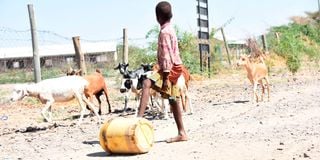
A gilrl pushes a jerrican of water at Lowareng’ak village in Turkana County on October 12, 2022 amid a biting drought.
Kenya has a robust meteorological department that has not slacked in warning us about impending droughts. We are a small country with huge diversity, from the arid and semi-arid regions, to the cool highlands giving way to the ice-peaked mountain, down to the hot and humid coastline, in addition to the rift valley ploughing down right through the middle.
This diversity means that we experience the good, the bad and the ugly and must live in anticipation of natural disasters. This same diversity is the very reason we can glaringly see the effects of climate change in every corner we turn. There is no running away from it.
As our forest cover continues to be depleted in the undeterred rape of our water towers, we have witnessed the drying up of our streams, which in turn feed our waters. Our seasons have dramatically changed and food security is no longer a guarantee in our country. Farmers who previously depended on one season of harvest to feed their families and have some produce left over for sale now have two or more planting seasons in a bid to put food on the table.
The end result of this is that one million children under the age of five in Kenya are malnourished; an additional 134,000 others will be born to women who are malnourished in pregnancy. We haven’t even talked about the rest of the population in the affected counties.
Seeing pictures of these women and children is devastating. Knowing that for most of them, no form of relief has arrived yet in an effort to salvage the situation is glaring neglect from those tasked with emergency response in these dire situations. We have known for three years that this was inevitable. We did not put much effort to mitigate the ravages of the drought and we are now in the phase of knee-jerk responses.
What does this mean to our children? The malnourished pregnant mother is likely to give birth to a low-birth weight baby. This same baby born in the drought-stricken area faces immediate malnutrition through the period of exclusive breastfeeding and the weaning phase.
If this child even survives, it is going to be a life of chronic malnutrition and its attendant complications. the problems of these children do not end when the food arrives. They live with the impact of the malnutrition for the rest of their lives.
The young girl will grow up to be a woman of small stature, a factor that negatively affects her child-bearing potential, with increased risk of pregnancy and childbirth complications such as need for caesarian delivery, fistula and poor neonatal outcomes.
The young child is likely to have impaired cognitive development and this will manifest itself throughout life; the delayed childhood milestones, difficulty in learning as evidenced by low IQ, poor school performance, and behavioral problems over their lifetimes, poor immunity with increased susceptibility to infections and poorer treatment outcomes.
The young child exposed to malnutrition has already been set on a path to oblivion. Malnutrition precipitated by to food insecurity is most likely going to affect the child from a disadvantaged background. This child’s hope of reversal of the situation depends on emergency aid and once the emergency has passed, he is left to survive within his environment.
This little one may have been rescued from imminent death and given a survival pass, but babies are not born to survive, babies are born to thrive. The child’s struggle with learning means that her opportunity to manifest their best abilities has been nipped at the bud. Difficulty in behaviour may interfere with her ability to relate well enough to put her best foot forward when competing for an equal opportunity position. Throughout their life, they are more likely to get infections, they are less likely to survive them and are more likely to suffer the sequelae of these infections.
It is not possible to watch this chain of events and fail to connect the dots. As a nation, we seem to have made it business as usual that 50 per cent of the populace is inconsequential. Their health and economic prosperity is not relevant to the well being of the nation as a whole.
As we talk about climate change, let us take a moment to reflect on the direct impact and the not so direct impact that leads to denial of the basic constitutional and human rights of a segment of our population, that not only impacts them now, but for the rest of their lives.
We must never condemn our children to being children of a lesser God!
Dr Bosire is an obstetrician/gynaecologist
How air pollution is destroying your health
By Dr Flo
Dear doc,
Are the concerns about air pollution realistic, especially as related to health?
Dear reader,
According to the World Health Organisation, 99 per cent of the world population breathes in air that contains unacceptable levels of air pollutants. Air pollution is currently considered as the largest environmental health threat and is responsible for over seven million deaths globally per year. Air pollutants include particulate matter (dust, dirt, soot, smoke and liquid droplets), carbon monoxide, nitrogen dioxide, sulphur dioxide and ozone. Indoor air pollution is generated by using firewood, charcoal, animal dung, crop waste or kerosene as fuel.

A herd of cattle feeding besides a burning pile of garbage at Mukuru Kayaba slums, Nairobi on March 22, 2020.
Outdoor sources of the pollutants include industries, motor vehicles, agricultural chemicals, waste burning, and forest fires.
Air pollution has both short term and long-term health consequences and it also contributes to global warming and climate change. Once the pollutants are inhaled, they settle in the respiratory system, and the smallest particles find their way to the air sacs (alveoli) and blood vessels. From here, the impact may be felt in all the body systems, including the nervous system, the reproductive system, and body organs such as the liver and the spleen.
Air pollution is associated with headache, anxiety, reduced lung function, worsening asthma, irritation of the eyes, nose, throat and the lower respiratory tract; increased risk of lung infections; chronic obstructive pulmonary disease, heart and diseases including stroke, and also cancer. Older people, children and those with pre-existing conditions are more likely to face greater health challenges due to air pollution.
The challenge of air pollution is global and requires global strategies and implementation. Kenya has a current National Climate Change Action Plan 2018 to 2022 to further the country’s sustainable development by providing mechanisms and measures to achieve low carbon climate resilient development, and one of its priority areas is health, sanitation and human settlements.
At a personal level, individuals can utilise clean fuels as much as possible, stop smoking, decrease the use of aerosols and chemicals, and where possible, live (and work/study) in an area with minimal pollution. Individuals can also participate in personal, community and national initiatives associated with environmental preservation/improvement.
Sometimes bad breath comes from my stomach and this is worrying me. What can I do?
Moha
Dear Moha,
Bad breath, otherwise known as halitosis, or fetor oris, can be caused by certain foods, habits or health conditions.
When you don’t brush or floss your teeth thoroughly, food particles that remain in the mouth after we eat begin to rot, and can also cause excessive growth of bacteria, which leads to bad breath. This can also lead to tooth decay and gum disease, which also contribute to bad breath.
Some foods have very strong smells like onions and garlic, spices, fish, alcohol, and some cheeses, and though the smells can be masked temporarily by brushing teeth and using a mouth wash, the smell remains until they pass out of the body, and the bad smell will seem to come from the stomach.
Also, eating very little starch, for instance when fasting, or when a diet causes the body to break down fats, and this leads to making of ketones, which produce a fruit-like smell when you breath out. Smoking and chewing tobacco also lead to bad breath and gum disease.
Another cause of bad breath is dry mouth due to reduced flow of saliva caused by a salivary gland problem or mouth breathing, or by some medicines.
Some medical conditions can also contribute to bad breath like throat infection, tonsillitis, gum disease, sinusitis, lung, kidney or liver disease, problems in the gastrointestinal tract like reflux (heartburn) and others.
Bad breath in the morning is caused by accumulation of bacteria in the mouth overnight. In addition, some people sleep with their mouths open, especially when they are snoring.
To deal with bad breath, brush your teeth at least twice a day or after meals with a fluoride toothpaste, brush your tongue, floss regularly and replace your toothbrush after three months. You can also use a mouth wash. It also helps to take a lot of water, chew sugarless gum, chew on mint or parsley, avoid strong smelling foods, and stop smoking or chewing tobacco and reduce alcohol intake.
You would benefit from a thorough medical check up to see if there are any underlying medical conditions, and these should be treated to prevent the bad breath. It is also important to get a dental check-up twice a year even when there is no pain in the teeth or gums. Usually with the dental hygiene and treatment of any underlying problems, the problem should be resolved within a short time.
Send your health questions to: [email protected]

